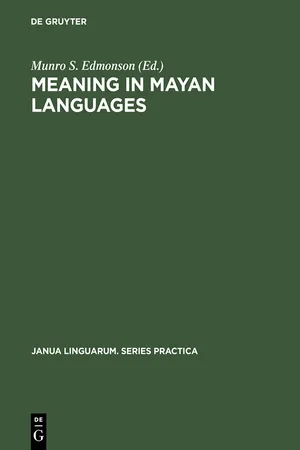
This is a test
- 256 pages
- English
- PDF
- Available on iOS & Android
eBook - PDF
Meaning in Mayan Languages
Book details
Table of contents
Citations
Frequently asked questions
At the moment all of our mobile-responsive ePub books are available to download via the app. Most of our PDFs are also available to download and we're working on making the final remaining ones downloadable now. Learn more here.
Both plans give you full access to the library and all of Perlego’s features. The only differences are the price and subscription period: With the annual plan you’ll save around 30% compared to 12 months on the monthly plan.
We are an online textbook subscription service, where you can get access to an entire online library for less than the price of a single book per month. With over 1 million books across 1000+ topics, we’ve got you covered! Learn more here.
Look out for the read-aloud symbol on your next book to see if you can listen to it. The read-aloud tool reads text aloud for you, highlighting the text as it is being read. You can pause it, speed it up and slow it down. Learn more here.
Yes, you can access Meaning in Mayan Languages by Munro S. Edmonson in PDF and/or ePUB format, as well as other popular books in Languages & Linguistics & Linguistics. We have over one million books available in our catalogue for you to explore.
Information
Table of contents
- Preface
- Orthographic Note
- I. Introduction
- References
- II. Sound Symbolism in the Mayan Language Family
- Introduction
- Sound Symbolism
- Data and Analyses
- Implications
- References
- III. Semantic Aspects of Yucatec Dual-Object Constructions
- The Verbal Suffix -T in Yucatec
- Some Syntactic Properties of -T Verb Stems
- A Semantic Theory of -T Verb Stems
- Implications of the Semantic Theory for Syntax and Morphology
- References
- IV. Chortí Semantics: Some Properties of Roots and Affixes
- Contrast and the Paradigm
- Linking and Nesting Relations
- Personal Affixes, Grammatical Categories, and Semantic Components
- Roots and Thematic Affixes: The ACT Feature
- Some Derived Active Expressions
- Field Testing
- Some Implications and Conclusions
- References
- V. The Semantics of Social Categories in a Transformational Grammar of Jacaltec
- Data for the Model
- The Model
- Explanatory Adequacy
- Descriptive Adequacy
- Observational Adequacy
- Summary and Conclusion
- References
- VI. Acquisition of Botanical Terminology by Tzeltal Children
- Introduction
- Tzeltal Plant Taxonomy and Nomenclature
- Geographical Context
- Botanical Socialization
- Plant Trail Task
- Response Types
- Summary
- Developmental Trends
- Development in Typical Child
- Conclusion
- References
- VII. Cultural Significance and Lexical Retention in Tzeltal-Tzotzil Ethnobotany
- Introduction
- The Comparative Inventory
- Analytic Categories
- Cognate Sets of Tzeltal-Tzotzil Plant Names
- Cultural Significance and Lexical Retention
- References
- VIII. Compound Place Names in Chuj and other Mayan Languages
- Introduction
- Sources and Identification of Chuj Place Names
- The Nature of Chuj Geographical Nomenclature
- Compound Chuj Place Names
- Comparative Data on Compound Mayan Place Names
- References
- IX. Three Genres of Tzotzil Insult
- Joking Insults
- Ridicule and Criticism
- Formal and Informal Discourses
- Functional Differences
- The Same Content in Different Genres
- References
- X. Chamula Tzotzil Proverbs: Neither Fish nor Fowl
- Introduction
- The Proverb in the Taxonomy of Chamula Oral Tradition
- Proverbs and Contexts
- Dynamic of Proverbs
- Summary and Conclusions
- References
- XI. Semantic Universals and Particulars in Quiche
- References
- Index